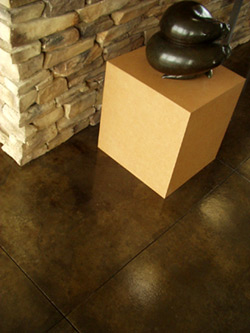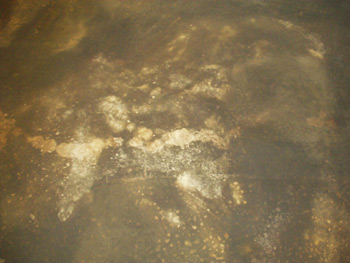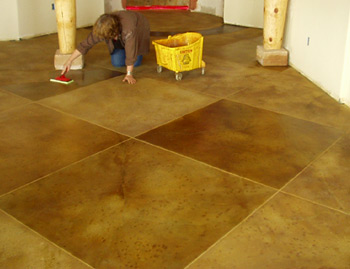 |
||||||
| March 31, 2005
Staining Floors Black Black is a supremely impractical color for floor staining. It must be a fairly easy color to produce, since every stain manufacturer has a color which they call "black." We try to discourage our clients from choosing black, or even a dark walnut shade for their floors, since the dust here in New Mexico is white. If someone does not wipe their shoes well before entering the house they will leave a clear trail of footprints across the floor. The homeowner will have to maintain a "no shoes in the house" policy or be dust mopping floors twice a day.
Despite our warnings, we have had three or four clients insist that they wanted black floors. Our next problem was to obtain it. Both Scofield and QC make colors they call black. Scofield's usually comes out as a cool dark brown, very close to their Dark Walnut color. We did samples of it next to QC Patina Stain's "Black" and the QC color was chosen by the client. The QC stain looked a tiny bit darker than Scofield's black on our test samples. The floor had been saw cut into squares 30 inches on a side. We poured the stain on for the first staining and brushed it into each square separately. We had a hard time keeping the floor consistent, since some gallons of the QC stain were almost solid black sludge and others were thin and watery.
Our next black floor was supposed to be a very dark walnut. The client had seen a concrete floor stained with wood stains (not a good idea for durability) and wanted that look. We mixed two colors by Scofield in the same bottle: one half Black and half Dark Walnut. We applied this color in several spray applications. It collected in low places in the floor but came out fairly even, nonetheless. (see Photo B).
Photo B Then we began having problems with Scofield's dark colors. A client insisted that we use straight Dark Walnut, even though he had two young children and several dogs planning to run in and out of the house. Despite our very best cleaning procedures, we got bad blotches in several parts of his house. It was as though someone had poured clear sealer or wax in spots. When we tried to touch up with another spray of color, our stain rain off the high areas and down to the same low areas, making the contrast even more noticeable (see photo C). We had to spend half a day doing faux paint touch-ups over our first coat of sealer in order to make the floors acceptably even.
Photo C We used to depend on being able to dilute Scofield's Dark Walnut in half with acid water (in a ten-to-one solution the greater part being water) in order to obtain a nice moderate brown color which I called "paper bag brown." It was the only brown we could make which had no orange in it. Something has changed in the last year or two, however. Either Scofield has changed their Dark Walnut formula, or all the concrete plants in our locale have changed theirs. We did several "dilute DW floors." as we called them with disastrous results. The stain was separating out into pure gray and pure walnut spots and not staying mixed. One floor had such regular blotches that the client called it "tortoiseshell" and liked it. The builder, a faithful repeat customer, took us aside and said "That's the ugliest floor you've ever done." We reluctantly agreed. We have since been experimenting with another brand of stain – Dayton Superior's Pro Patina stains. They use a different, milder sort of acid as a base. Their color chart resembles all the other manufacturers' but the stain acts quite differently. It appears not to "bite in" as quickly when it hits the floor. In fact their colors take six hours instead of four to develop and we usually give them all night to cure. We spray on the first coat, wait until it is dry enough to walk upon (3 or 4 hours in our climate), then spray the entire slab again and leave it until morning. The big advantage is that we are rarely getting blotches. Dayton also makes a Stain Extender, which is sold by the gallon and is the clear base used in all their colors. So instead of taking our chances with our own concoction of acid-water, we know we are diluting with the correct base. We are getting nice even dilutions of all their dark colors, but their Black is especially pleasing. It gives a moderate cool brown at half the cost of the stains we had been using. This photo of a model home we did recently shows the results of a 2-to-1 dilution of Dayton's Black stain with their Extender. One of our workers is applying clear sealer (Sheen C-40 by Harvard Chemical Research) with a painting pad. The client wanted each square to be a slightly different color (see Photo D). Instead of trying to get such subtle differences with stain, we tinted several small buckets of sealer with different acrylic colors. One had some blue added, one some red and one some gray-green. We sealed the squares in a random order and got a very pleasing random checkerboard effect. This photo shows the process. The palest squares are those which have not yet been sealed. We typically use five coats of Sheen C-40, tinting only the first two coats. After that we apply the sealer straight, so that minor scratches do not reveal another color underneath.
Photo D I have heard through the Forum that some stainers are having problems with Sheen C-40 staying sticky or turning white. It works well in our climate, but use whatever sealer you feel comfortable and familiar with in your locale. Be careful to mix only a translucent artist's acrylic pigment (of high quality) with a bit of sealer to liquefy it smoothly first, before adding it to your whole bucket of sealer. It only takes a smidgeon. Our red-tinted sealer, for example, looks pale pink in the bucket. It dries clear, of course. When we want a true, very dark black, we have found Elite Crete's Black stain and Dayton Superior's to be the darkest. When sealed with a solvent-based sealer they are no longer a very dark brown but actually black. Happy Staining! GG |
||||||
|
|
||||||




